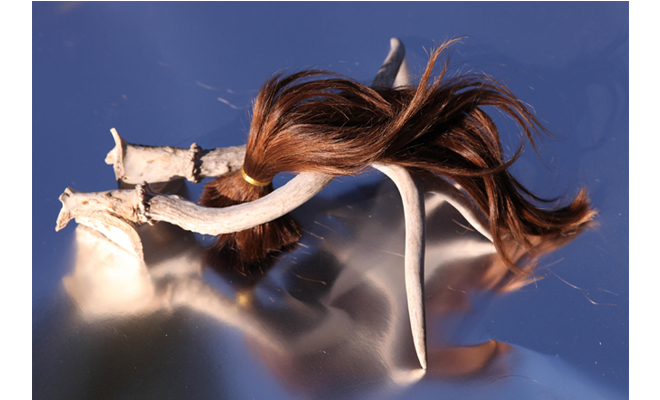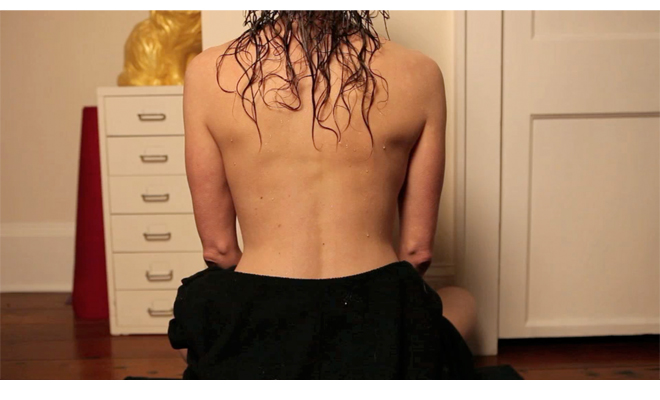Review: Valerie Corradetti and Ariya Martin at TEN Gallery

Ariya Martin and Valerie Corradetti, The standards by which you measure yourself #5, 2013. Metal print. Courtesy the artists.
Contrast teaches. As children, we learn textures by comparison with others: smooth versus rough, or hard versus soft. Gradually expanding our awareness of the world, all the while narrowing down the right words to describe it, we eventually obtain a mastery not just of the concept but of the uses to which contrasts are put: how they slow our attention to focus on interruptions, shifts, or gaps that reveal something about the world around us. Long may this education continue. In their new show at TEN Gallery, “I like coconuts. They remind me of the good times.”, Valerie Corradetti and Ariya Martin offer a sustained set of meditations on the virtues and lessons that contrast offers.
A series of photographs entitled The standards by which you measure yourself (#1-5), 2013, depicts a set of objects—antler bones, found stones, and cut tufts of each artists’ hair—arranged against a hazy, reflective backdrop and photographed at extremely close range. (The tufts of hair are also works in the show, mounted on pedestals in the center of the room.) These photographs began as a collaboration, stemming from a shared interest in the histories and meanings of personal objects—modern talismans, objects holding special mnemonic, domestic, and artistic significance. Originally a series of approximately 40 images, Corradetti and Martin winnowed the selection down to five, both freely admitting that their level of collaboration was so intertwined that neither now knows who was ultimately responsible for any one particular image.
On one level, these photographs exist in a kind of nether-space, their horizon lines evoking the ocean photographs of Hiroshi Sugimoto. These arrangements are somewhere and nowhere at once, standing out in sharp focus even as their mirrored reflection fades silkily into a pool of thin air. Their ephemeral backdrop contrasts starkly, however, with the hard, angular physicality of the objects themselves. What could be more real and solid than the raw, guttural elements of bone, rock, and hair? Other tensions underlie the arrangement, such as the timelessness of rock versus the transience of hair, or the impermeability versus the pliability in the same, or the sharp linear form of the antler versus the irregular knotted tangle. It’s a powerful lesson: the closer one gazes at each form and follows the contrasts to their conclusion, the more detail is revealed.
The rewards of that examination are equally present in the other photographs in the show, Conversion, 2013, and Am I different now (1 & 2), 2013, a linked series of large-format images of the top portion of both artists’ heads, shot from the forehead up. Corradetti and Martin have given us two ways to view these images—Conversion is mounted vertically against a back wall, while the diptych, Am I different now, is mounted horizontally. It’s tempting at first to read these images as a satire on, say, the impossibly burnished locks of a Pantene shampoo ad, with its stereotyped, predictable notions of female beauty, but the photographs preclude those notions by eliminating any other identifiable physical markers (eyes, face, or body) to promote a deeper, stranger beauty in forms.
The effect is twofold: at close range, the viewer is able to explore the remarkable paths, tracks, and weaves found in the sets of hair. The intimate, almost granular level of detail allows for a kind of voyeurism—but, importantly, not a sexual voyeurism, rather an opportunity to marvel at the complexity and beauty, the subtle mathematics, of the human form. Moving from the micro to the macro level, the framing of these details (the cropping of each shot, the reverse juxtapositions, the hairlines flowing into one another) creates in the vertical mounting a mirroring which leads the ovals of the two heads to resemble other objects entirely—plates overflowing with food, decorated eggs, even rivers and lakes flowing alongside a plain. In so doing, the subjects of these images cease almost to be heads at all.
These contrasts between the known and the unknown, the solid and the fluid, reach their fullest expression in the video installation Still so still, 2013, a set of two side-by-side projections in a curtained-off corner, each lasting about six minutes. The videos feature Corradetti and Martin respectively, each sitting shirtless on the floor with her back to the camera, largely motionless, her hair and skin wet as though she had just stepped out of a bath. Set to a soundtrack of an intermittent gong and quiet domestic noise, the videos lead the eye to observe the motion of the water droplets running down the otherwise still backs, as well as the occasional twitch of spinal muscles. These involuntary actions, occurring underneath and above the surface of the skin, become hypnotic. In an installation composed of so much stillness, the eye cannot help but seek any point of movement. But as with all the works in this show, once found, it is impossible, as a viewer, to remain unmoved.

Ariya Martin and Valerie Corradetti, Still so still, 2013. Digital video (still). Courtesy the artists.
Editor's Note
“I like coconuts. They remind me of the good times.” is on view until June 30 at TEN Gallery (4432 Magazine Street) in New Orleans.



